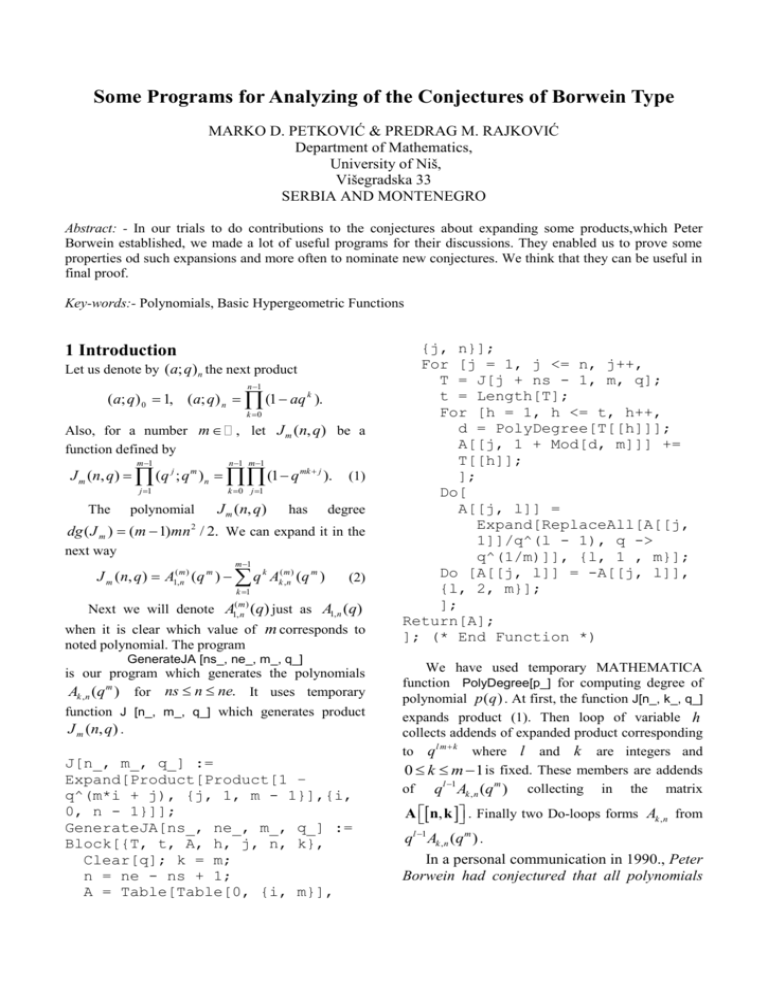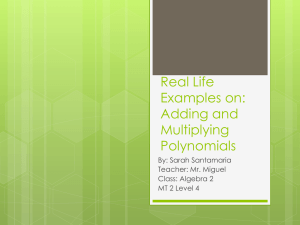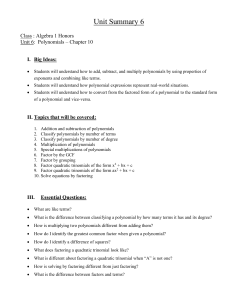488-376
advertisement

Some Programs for Analyzing of the Conjectures of Borwein Type
MARKO D. PETKOVIĆ & PREDRAG M. RAJKOVIĆ
Department of Mathematics,
University of Niš,
Višegradska 33
SERBIA AND MONTENEGRO
Abstract: - In our trials to do contributions to the conjectures about expanding some products,which Peter
Borwein established, we made a lot of useful programs for their discussions. They enabled us to prove some
properties od such expansions and more often to nominate new conjectures. We think that they can be useful in
final proof.
Key-words:- Polynomials, Basic Hypergeometric Functions
1 Introduction
Let us denote by (a; q) n the next product
n 1
(a; q ) 0 1, (a; q ) n (1 aq k ).
k 0
Also, for a number m , let J m (n, q) be a
function defined by
m 1
n 1 m 1
j 1
k 0 j 1
J m (n, q) (q j ; q m ) n (1 q mk j ).
The
polynomial
J m (n, q)
has
(1)
degree
dg ( J m ) (m 1)mn 2 / 2. We can expand it in the
next way
m 1
J m (n, q) A1(,mn ) (q m ) q k Ak( m,n) (q m )
(2)
k 1
Next we will denote A1(,mn) (q) just as A1, n (q)
when it is clear which value of m corresponds to
noted polynomial. The program
GenerateJA [ns_, ne_, m_, q_]
is our program which generates the polynomials
Ak , n (q m ) for ns n ne. It uses temporary
function J [n_, m_, q_] which generates product
J m (n, q) .
J[n_, m_, q_] :=
Expand[Product[Product[1 –
q^(m*i + j), {j, 1, m - 1}],{i,
0, n - 1}]];
GenerateJA[ns_, ne_, m_, q_] :=
Block[{T, t, A, h, j, n, k},
Clear[q]; k = m;
n = ne - ns + 1;
A = Table[Table[0, {i, m}],
{j, n}];
For [j = 1, j <= n, j++,
T = J[j + ns - 1, m, q];
t = Length[T];
For [h = 1, h <= t, h++,
d = PolyDegree[T[[h]]];
A[[j, 1 + Mod[d, m]]] +=
T[[h]];
];
Do[
A[[j, l]] =
Expand[ReplaceAll[A[[j,
1]]/q^(l - 1), q ->
q^(1/m)]], {l, 1 , m}];
Do [A[[j, l]] = -A[[j, l]],
{l, 2, m}];
];
Return[A];
]; (* End Function *)
We have used temporary MATHEMATICA
function PolyDegree[p_] for computing degree of
polynomial p ( q ) . At first, the function J[n_, k_, q_]
expands product (1). Then loop of variable h
collects addends of expanded product corresponding
to q l m k where l and k are integers and
0 k m 1 is fixed. These members are addends
of ql 1 Ak , n (q m ) collecting in the matrix
A n, k . Finally two Do-loops forms Ak , n from
ql 1 Ak , n (q m ) .
In a personal communication in 1990., Peter
Borwein had conjectured that all polynomials
Ak , n (q) have nonnegative coefficients for m=3
and m=5.
According to results obtained by our
programs, we can establish two conjectures.
Conjecture 1. (The first Borwein type conjecture)
For any number m N , the polynomials
A1, n (q) (n 1,2,) have nonnegative coefficients.
m -even number and n -odd, besides
A1, n (q) (n 1,2,) , we can notice one more
For
polynomial sequence with nonegative coefficients.
Conjecture
conjecture)
2. (The second Borwein type
For any even number m N and
Mod [(m 1)mn2 , m] 0 , the coefficients of
the polynomials A 1, n (q) ( n N ) are nonegative.
Example 1.1. For concrete values m 6 and
n 1 , we have
J 6 (1, q) 1 q q 2 q5 q 6 q 7 q8
10
13
14
on Make [n_, m_, q_] finds matrix F (m, n, q ) in the
recurrence relation
An F (m, n, q) An1, n N .
m 1
Tn (q ) (1 q m ( n 1) i ).
i 1
When we replace J m (n, q) and J m (n 1, q) with
(2), and expand right side by collecting addends
corresponding to same ql (0 l m 1) , we obtain
(4)
The matrix M i , j ( q ) is equal to F (m, n, q ) . The
Let An A1, n (q), A2, n (q),, Am, n (q) . . Our functi-
where
j 1
J1,1 (q) q 1, J 4,1 (q) q 2 q.
J m (n, q ) J m (n 1, q ) Tn (q)
n
15
hence
2 The matrix form
The main idea is to represent (1) in a form
Ai , n (q m ) M i , j (q)Aj , n 1 (q m ) .
q q q q q
9
For [j = 1, j <= t, j++,
Tm=ReplaceAll[Tmp[[j]], n ->
(m+1)];
tm = Mod[PolyDegree[Tm], m];
Tm1 = ExpandAll[ReplaceAll[
Tmp[[j]]/q^tm, q ->
q^(1/m)]];
If[tm > 0, Tm1 = -Tm1];
A[[tm + 1, h + 1]] += Tm1;
];
];
Return[A];
];
(3)
Make[n_, m_, q_] :=
Block[{Var, h, i, j, l, T, t, Anm1,
An, A, Tmp, Tm, tm, Tm1},
Clear[Var];
A =0* IdentityMatrix[m];
T = ExpandAll[Product[1 - q^(m*(n
- 1) + j),{j, 1, m - 1}]];
Anm1 = ExpandAll[Var[0] – Sum
[Var[i]*q^i, {i, m - 1}]];
An = ExpandAll[Anm1*T];
t = Length[An];
For [h = 0, h <= m - 1, h++,
Tmp = Coefficient[An, Var[h],
1];
t = Length[Tmp];
product J m (n 1, q) is represented by Anm1 in our
program and right side of equation (4) is computing
with An = ExpandAll[Anm1*T]; where T represents
Tn (q ) . The next loop (of variable h ) forms
polynomials M i , j ( q ) . Polynomials Aj , n 1 (q) are
represented via array of temporary symbolic
variables Var[j]. First we take addends with common
Var[h] in variable Tmp. Then, we are grouping addends corresponding to ql m k and finally obtaining
A[[tm+1,h+1]], elements of matrix F (m, n, q ) . Note
that input parameters n and q are symbolic
variables and m is integer. The resulting matrix A
(representing F (m, n, q ) ) is a function of n and q .
Example 2.1. For m 3 , we have
1 q 2 n 1
qn
qn
F (3, n, q) 1 q 2 n 1 1 q 2 n 1 1 q 2 n 1 .
q n 1
q n 1 1 q 2 n 1
Relation (3) can be used for computing The
next algorithm computes An by using the relation
(3) for given matrix F (n, m, q ) which can be
computed by the function Make [n_, m_, q_].
MatrixGenerator[nn_, k_, q_, F_]
:= Block[{AaA, i, j},
Clear[AaA];
AaA[0] = Insert[Table[0, {j,
k - 1}], 1, 1];
Do[AaA[i + 1] = ExpandAll[
ReplaceAll[F, n -> (i + 1)].
AaA[i]]; , {i, 0, nn - 1}];
Return[Table[AaA[i], {i, 1,
nn}]];
];
Here input matrix F is functional matrix of
symbolic variables q and n . Output is list consists
of elements An for 1 n nn .
Print["Simplifying system....."];
Sys = Simplify[Sys];
Print["Solving....."];
sol = Solve[Sys, Table[Var[i],
{i, 2, d}]];
Print["Simplifying
solution....."];
sol = Simplify[sol,
TimeConstraint -> 600];
J = ReplaceAll[A[[d, 1, 1]],
sol[[1]]];
Print["Simplifying J....."];
J = Simplify[J];
J = Collect[J, Union[{Var[1]},
Table[Var[1, i], {i, 1, d}]]];
Return[J];
];
Main idea is to make a system of ( m 1)
equations
3 Fundamental recurrence relation
It seems to be of great importance to find separate
nN ,
recurrence relations for the sequences A1,n (q )
i 1,
with
Var 2 ,
variables
,Var m
(k 2,
An , k
, m)
and to replace its
solution to m th equation ( A d ,1,1 0 ).
Using vector equation (3), it can be easily obtained
An1 Fi* m, n, q An
, m . Program Fundamental [F] finds funda-
mental recurrence relation for matrix computed by
function Make [n_, m_, q_].
where
Fundamental[F_] :=
Block[{Sys, J, J1, h, i, n, d, M,
A, CF},
Clear[Var];
{d, d1} = Dimensions[F];
A = Table[0, {d + 1}];
M = IdentityMatrix[d];
A[[1]] =
Var[1, 1] {First[ReplaceAll[F,
n -> n + 1]]}.
Table[{Var[i]}, {i, d}];
Do [
M = ExpandAll[ReplaceAll[F,
n -> n + h - 1].M];
A[[h]] =
Collect[ExpandAll[{{Var[1,
h]}} - {First[
ReplaceAll[F, n -> n +
h]]}.M.
Table[{Var[i]}, {i, d}]],
Table[Var[i], {i, d}]];
, {h, 2, d + 1}
]; (* End Do h*)
Sys = Table[A[[h, 1, 1]] == 0,
{h, 1, d - 1}];
Also, it holds
Fi* m, n, q F m, n i, q
m
F m, n 1, q .
Ani ,1 Fi* m, n, q
j 1
1j
Aj ,1 .
(5)
Previous equations, for i 1, , m 1 , form
system of independent linear equations (parameter
An i ,1 is contained only in i th equation) of
variables
An , j , j 2,
, m . When we replace
solution of this system into ( m 1) th equation we
obtain equation
G An ,1 ,
, An m 1,1 0
which is fundamental recurrence equation of
sequence An ,1 .
In the first Do - loop, we are forming equations
(5). Product Fi* m, n, q An is computing iteratively and is represented by M . Equations are storing
in variable A and are being computed by definition
in body of loop. Next, we are solving formed
system, replacing solution to ( m 1) th (in code,
we used variable d for m , so equation is d+1-th)
equation and obtaining fundamental relation. In all
code we use MATHEMATICA function Simplify in
order to reduce expressions we obtain.
The next theorems deal with general recurrence
relation for concrete values m 2 and m 3 .
n 1 m 1
2
2
1
q n m( m 1) 2 J m (n,1 q) q n m( m 1) 2 1 mi k
q
i 0 k 1
n 1 m 1
i 0 k 1
Theorem 3.1. For m 2 , the sequences Ai ,n (q ) ,
(i 1, 2) satisfy the same recurrence relation
(1)n ( m 1) J m (n, q)
m
2
q n m( m 1) 2 A1,n 1 q m q ( k 1) Ak ,n 1 q m
k 2
with only difference in initial values.
1
Theorem 3.2. For m 2 , the sequences Ai ,n (q ) ,
(i 1, 2,3) satisfy the same recurrence relation
F n 1q(1 q q )(1 q
q
n ( m 1)
m
m
A
q
q k 1 Ak ,n q m
1,n
k 2
)
F n q 3 (1 q 3n 1 )(1 q 3n 2 )
1
with only difference in initial values:
F n A1,n : F 0 1, F 1 1 q,
m
q n m( m 1) 2 A1,n 1 q m q n m( m 1) 2( k 1) Ak ,n 1 q m
2
4n 4
i.e.
F n 3 F n 2 (1 q q 2 )(1 q 2 n 3 )
2n2
we have
F n 2 (1 q) F n 1 (q q 2 n 2 ) F n 0
2
q mi k 1
2
k 2
m
A1,n q m 1
n ( m 1)
n ( m 1)
k 2
q k 1 Ak ,n q m
wherefrom conclusions follow.
F 2 1 q 2q q q ,
2
3
4
F n A2,n : F 0 1, F 1 1, F 2 1 q q3 ,
F n A3,n : F 0 1, F 1 1, F 2 1 q2 q3.
We have generated recurrence equations for
m 4,5, 6, 7 , but these relations are rather
complicated, and that is why they are not presented
here. Also for m 6 and m 7 our program needs
large amount of time to produce the result, because
polynomial and rational expressions obtaining by
our program are so large. Also, the matrices
F (m, n, q ) have large polynomials as its elements.
5 The zeros
Let us remind that a polynomial
P q qk 1
k
has the zeros
2
qk , j exp i
j 1
k
j 1, 2,
,k
i
1
which have the property
k , mod l , k 0
j 1
0, mod l , k 0
We will denote by sl the sum of l the powers of
k
q
l
k, j
4 Reciprocal polynomials
Let us notice some reciprocal polynomials.
all zeros of J n, q , i.e.
n 1 m 1 mk 1
Theorem 4.1. The polynomial A1, n ( q ) is reciprocal
l
sl qmk
j ,i .
itself and the polynomial Ak 1,n ( q ) is reciprocal to
the polynomial Am k 1,n ( q ) , i.e.,
A1,n q 1
Ak 1,n (q) (1)
n ( m 1)
n ( m 1)
(k 1, 2,
Proof. Starting from
q
qn
2
( m 1) 2
n 2 ( m 1) 2
k 0 j 1 i 1
Hence
A1,n 1 q
Am k 1,n (1 q)
, m 1) .
n 1 m 1
sl mk j k ',0 k 'mod l ,mk j
k 0 j 1
where k , j is Kronecker delta.
Obviously, sl 1 . If l is a prime number
greater than m n 1 m 1, then sl 1 .
Now, the coefficients of the polynomial
1
( m 1) n
J n, q q mn d n ,1q mn
2
2
1
Note that values of sl are very small compared
with d n , k . For n 20 and m 3 , maximal value
d n ,mn2 1q d n ,mn2
and the sums sl are connected by Newton's
formulae
sl d n,1sl 1
d n,l 1s1 ld n,l 0
(l 1, 2,
6 Conclusion
, mn2 ).
or
d n ,l
1
sl dn,1sl 1 dn,l 1s1
l
(l 1, 2, , mn2 ).
sl is 190 and maximal d 20,k is 21645518 .
(6)
wherefrom we get much faster algorithm for evaluating of the coefficients d n , k . Next is a code of
function GenerateNewtonAi[n_, m_, q_] which
generates vector An .
GenerateNewtonAi[n_, m_, q_] :=
Module[{dgJ, h, j, k, l, m, n,
s, a, list, mm},
dgJ = (m - 1)*m/2*n^2;
Do[s[nn] =
Sum[(m*k + j)*
KroneckerDelta[
Mod[nn, m*k + j], 0],
{j, 1, m - 1},
{k, 0, n - 1}];
, {n, 1, dgJ}];
a[0] = 1; a[1] = -s[1];
Do[
a[mm] = -(s[mm] +
Sum[a[j]*s[mm - j],
{j, 1, mm - 1}])/mm;
, {mm, 2, dgJ}];
list = Table[0, {i, 1, m}];
list[[1]] = Sum[a[m*k]*q^k,
{k, 0, dgJ/m}];
Do[
list[[i]] =
-Sum[a[m*k + i - 1]*q^k,
{k, 0, dgJ/m - 1}];
, {i, 2, m}];
Return[list];
];
In this paper, we presented some algorithms and
programs for analyzing conjectures of Borwein type.
There are presented 3 algorithms for computation of
polynomials Ak , n . From the computed polynomials,
we conjectured two generalizations of Borwein
conjecture. Next we made a programs for computing
the matrix F n, k , q in recurrence relation (3), and
separate (fundamental) recurrence relation for the
sequence
A
1,n n
. Also we presented some
theoretical results obtained by our programs. For
further research, it seems to be interesting to
consider sequence sl and relation (6) because
values of sl are positive and small, and relation (6)
makes a nice recurrent connection between
coefficients of polynomials J m (n, q) and also Ak , n .
References:
[1] G. E. Andrews, On a Conjecture of Peter
Borwein, J. Symbolic Computation, Vol. 20,
1995, pp. 487-501.
[2] D. M. Bressoud, The Borwein Conjecture and
Partitions with Prescribed Hook Differences,
Electronic J. Combinatorics, Vol. 3, No. 2,
1996, pp. 1-14.
[3] R. Koekoek and R. F. Swarttouw, Askeyscheme of hypergeometric orthogonal polynomials and its q-analogue, Report No. 98-17,
Delft University of Technology, 1998.
[4] S. Ole Warnaar, The generalized Borwein
conjecture. I. The Burge transform, to appear in
Contemporary Mathematics,
arXiv:mathCO/001220, 2000.
[5] S. Ole Warnaar, The generalized Borwein
conjecture. II. Refined q-trinomial coefficients,
arXiv:mathCO/0110307, 2001.








